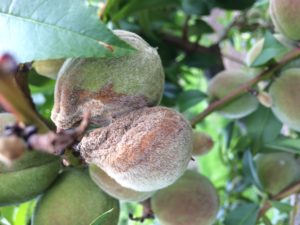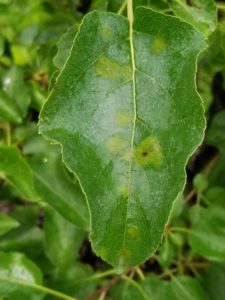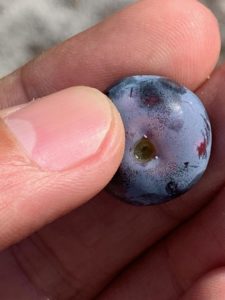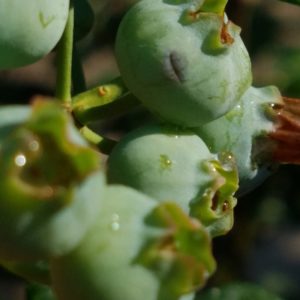Peach:
Plum Curculio (PC): PC oviposition should be done in all areas of the state, and there is up to 2-3% of fruit injury with egg scars. We have accumulated about 911 DD since petal fall (apple) in southern counties and just over 663 DD in Hunterdon County. The Cornell model calls for insecticides applied up to the 340 DD50 mark. Therefore, all sprays for this insect should be done. The model assumes a single generation in NJ, which is historically what we have had. New research from Anne Nielsen’s lab is telling us that the southern strain of PC is also present in the state. This is a multi-voltine strain, which means there is more than one generation per year in some parts of the state. Therefore with an early spring, we may see additional injury later in the season.
Oriental Fruit Moth: Second generation timings are updated below. According to the model, treatments for second generation should start in about a week in southern counties.
| OFM 2nd Degree Day (DD) Timing | ||||
| Insecticide Type | ||||
| County/Region | Biofix | DD by 5/27 base 45 | Conventional
1150-1200, 1450-1500 |
Diamide
1075-1150, 1375-1450 |
| Gloucester – Southern | 4/8 | 1076
|
1st – 6/7-8
2nd – 6/15-18 |
1st –6/3-6
2nd – 6/11-15 |
| Hunterdon – Northern | 4/16 | 750 | 1st – About 6/16-20
2nd – too far off |
1st – About 6/13-16
2nd – too far off |
Scale Insects: In Southern Counties, White peach scale (WPS) crawlers began to emerge 5/14-15, or about 2 weeks earlier than in a “normal” year. San Jose scale (SJS) crawlers began emergence about 5/24. If you have scale infestations on your trees, it is important to note if crawlers are present, even if you treated with oil in the early spring. If crawlers are present then treatment options include Esteem, Movento, Centaur, Venerate, and Diazinon. These materials can still be applied. Venerate needs to be applied at the low rate of 1 qt/A. Diazinon is labeled for only one post bloom or foliar application on stone fruit (Rec = max. of 2 lb/acre of the 50W).
Peach Scab: Maintain good coverage with captan or other effective fungicides until July, where scab was an issue last year.
Bacterial Spot: Fruit lesions are now visible in southern counties. Fruit remains highly susceptible but will develop some resistance after pit hardening. The pit hardening process is going on now, and should be compete over the next week.
Rusty Spot: Rusty spot infections are ongoing until pit hardening. Maintain coverage with effective materials such as Rally, Rhyme, or potassium bicarbonate products.
Brown Rot: Maintain coverage with effective materials until pit hardening. With the weather pattern we have been experiencing, use a Captan based program, or alternate non-sulfur materials with Captan. We are seeing some brown rot show up on green fruit in non-sprayed blocks. This is significant and points to the disease pressure we are experiencing, since we do not normally see infected fruit at this time of year (Figure 1).

Figure 1. Brown rot on green fruit. (Photo L. Blaus)
Apple:
Codling Moth (CM): The first codling moth flight is well underway. A biofix was set for CM on April 25th in southern counties and on May 1 in Hunterdon County. Trap counts in some orchards are quite high, or above the 5 moth per trap action threshold. If your orchard has populations that reflect these numbers, then continued insecticide coverage is warranted. Make sure to alternate chemistries, with no more than 2 consecutive applications of any 1 type of insecticide. If you have had problems in recent years, then consider adding 1 oz of Madex to the spray tank.
| Codling Moth Degree Day Timing | ||||||||
| Application and Insecticide Type | ||||||||
| County Area | Biofix | Rimon:
75-100DD + 14-17 days later
|
Intrepid
150 + 450 DD Diamides – Altacor, Voliam mixes: (150-200 DD) + 14-21 days later |
Cyd-X, Madex
250 DD + every 7-9 days during brood hatch (later if first spray is an IGR) |
Standard Insecticides – Delegate, Avaunt, OP’s, carbamates, pyrethroids
250 DD + 550 DD
|
|||
| DD | 75 | 100 | 150 | 450 | 250 | 250 | 550 | |
| Southern | April 25 | Past | past | past | past | past | past | 6/2 |
| Northern | May 1 | Past | past | past | 6/6 | 5/24 | 5/24 | 6/10 |
Tufted Apple Budmoth (TABM): A biofix for TABM was set in southern county orchards on 4/25. The third alternate middle application or the second complete application for TABM will be this week in southern counties. No need for special targeted applications at this point, since this has been only of minor significance during the past 6-10 years.
Dogwood Borer (DWB): Adults are just starting to emerge in northern counties and have been flying for a several weeks in southern counties, and will continue to emerge and lay eggs over the next month. Adults are attracted to areas with burr knots and lay eggs in and around those areas soon after emergence. Burr knots are often present on certain Malling rootstocks, and when accompanied by flat spiral tree guards and poor weed control, the knot and dark moist areas encourage the insect’s survival. Insecticides should be applied to the trunk on infested and susceptible trees during the flight and egg laying period. A single application of Lorsban (Advanced or 4E), to the trunk will provide control. Use 1.5 Qt/100 gal of spray mix and do not contact anything else but the trunk, and make only 1 application per year. Some older and out-of-date recommendations outline multiple applications. This is no longer legal. See the following from the Lorsban label from Lorsban Advanced:
“Specific Use Restrictions:
- Preharvest Interval: Do not apply within 28 days before harvest.
- Do not make more than one application of Lorsban Advanced to the apple tree trunk per year as either a prebloom or postbloom application.
- This product may not be used if a prebloom application of any other product containing chlorpyrifos has been made during the year.
- Do not allow meat or dairy animals to graze in treated orchards.
- Treat only the lower 4 feet of the apple tree trunk.
- Do not apply when wind speed is greater than 10 mph.”
Apple Scab: The first primary scab infections were seen this past week in a northern orchard (Figure 2). If primary infections are present, these lesions should be burned out or deactivated in order to decrease the inoculum present for additional infections. Use .75 lb of Syllit + 1.5-2 lb a.i. of Captan in 2 full cover/every middle applications, or 2 applications of Inspire Super or Indar combined with Captan. Re-evaluate after those applications before moving on as ‘normal.’

Figure 2. Primary scab on leaves. (Photo A. Atanassov).
Scouting Calendar Tree Fruit Southern Counties
The following table is intended as an aid for orchard scouting. I t should not be used to time pesticide applications. Median dates for pest events and crop phenology are displayed. These dates are compiled from observations made since 1995 in Gloucester County. Events in northern New Jersey should occur 7-10 days later.
Pest Event or Growth Stage |
Approximate Date | 2019 Observed Date |
| Bud Swell (Redhaven) | March 23 +/- 15 Days | March 25 |
1/4″ Green Tip Red Delicious |
March 31 +/- 13 Days | March 27 |
Pink Peach (Redhaven) |
April 4 +/- 15 Days | April 4 |
Tight Cluster Red Delicious |
April 9 +/- 13 Days | April 8 |
Oriental Fruit Moth Biofix |
April 9 +/- 13 Days | April 8 |
Full Bloom Peach (Redhaven) |
April 9 +/- 14 Days | April 9 |
Pink Apple (Red Delicious) |
April 14 +/- 12 Days | April 16 |
Codling Moth Biofix |
April 27 +/- 13 Days | April 25 |
Green Peach Aphid Observed |
April 16 +/- 16 Days | Not yet observed |
Full Bloom Apple (Red Delicious) |
April 22 +/- 11 Days | April 20 |
Petal Fall (Redhaven) |
April 22 +/- 10 Days | April 19 |
Petal Fall (Red Delicious) |
April 27 +/- 14 Days | April 29 |
Shuck Split (Redhaven) |
April 30+/- 11 Days | April 24 |
First PC Oviposition Scars Observed |
May 3 +/- 18 Days | April 23 |
Tufted Apple Bud Moth Biofix |
May 4 +/- 10 Days | April 8 |
San Jose Scale Crawlers |
June 2 +/- 8 Days | May 24 |
Pit Hardening Peach |
June 16 +/- 8 Days | Not yet observed |
Tree Fruit Trap Counts – Southern Counties
| Weekending | STLM | TABM-A | CM | AM | OFM-A | DWB | OFM-P | TABM-P | LPTB | PTB |
| 4/27 | 8 | 1 | 3 | 110 | 29 | 0 | ||||
| 5/4 | 4 | 5 | 6 | 34 | 17 | 1 | 0 | |||
| 5/11 | 2 | 8 | 5 | 31 | 5 | 5 | 0 | |||
| 5/18 | 2 | 32 | 8 | 21 | 23 | 2 | 11 | 34 | ||
| 5/25 | 2 | 34 | 7 | 0 | 39 | 0 | 32 | 34 | ||
| 6/1 | 1 | 56 | 14 | 71 | 1 | 56 | 47 |
Tree Fruit Trap Counts – Northern Counties
| Weekending | STLM | TABM-A | CM | AM | OFM-A | DWB | OBLR | OFM-P | TABM-P | LPTB | PTB | |
| 4/6 | 0.3 | |||||||||||
| 4/13 | 2 | |||||||||||
| 4/20 | 10 | 0 | 0.2 | 0.9 | ||||||||
| 4/27 | 9 | 0 | 0 | 4 | 9.5 | 0 | ||||||
| 5/4 | 9 | 0.1 | 0.2 | 7 | 0 | 0 | 17.1 | 0.2 | 0 | |||
| 5/11 | 10 | 0.6 | 1.2 | 4 | 0 | 0 | 5.8 | 2 | 2.5 | 0 | ||
| 5/25 | 3 | 13.3 | 2.9 | 3 | 2 | 0 | 1.1 | 10.8 | 4.5 | 0 | ||
| 6/1 | 5 |
|
3.2 | 4 | 4 | 0.5 | 3.1 | 14.7 | 5.7 | 0 |
Blueberry
Plum Curculio (PC): PC adult counts are low, and early injured fruit is dropping to the ground. Some late injured fruit can still be found with live larvae, but most of these should be gone by the time the first fruit is picked. A little fresh injury is being seen in a few locations. While PC treatments are done for most growers, fresh injury deserves a material that includes some PC activity.
Aphids: Aphid populations have increased some over the last week. This insect is the primary target to control at the present time. Colonies are small with an average of 2.3% of lower shoots infested and a high of 22%. Growers will find it easier to get rid of the aphids before starting an effective SWD program The best materials for aphid control include the neonicotinoids (Group 4A materials), Assail (1 day PHI), Actara (3 day PHI), and Admire (7 day PHI); the 4D material Sivanto (3 day PHI), and Movento (7 day PHI Group 23). If you have fresh PC injury and aphids, then use the Actara.
Spotted Wing Drosophila (SWD): The first adult flies were captured this past week, with only scattered numbers on a couple of traps. The average number of SWD males per trap is only about .35 SWD/trap with a high of 5 per trap. Given the time between the first capture and the first Duke picking, we could have an entire generation of population increase. Starting late this week and next week, growers who have either controlled their aphids or don’t have aphids, should begin their SWD programs. Very effective materials include: a) any pyrethroid (Group 3A) – Brigade/Bifenture, Asana, Danitol, Hero, Mustang/Mustang Maxx, b) the organophosphates (Group 1B) – Imidan, Malathion, and Diazinon, c) the carbamate (Group 1A) – Lannate, d) the spinosyns (Group 5) – Delegate and Entrust, and e) the diamide (Group 28) – Exirel. As a general rule, the neonicotinoids and other materials meant for sucking insects like aphids, do not work well against SWD. Assail does have some activity, and if used early in the season on very light populations, can suffice as the first SWD spray if primarily targeting aphids.
Oriental Beetle (OB): The first Oriental beetle adults were captured in traps late last week in Atlantic County. OB adults will continue to emerge throughout June and the first half of July. They will mate and lay eggs shortly after emergence. After the larvae hatch from eggs, they burrow down into the shallow root system. Admire/imidacloprid needs to be applied so it is in the soil when young and newly hatching larvae are present. This would be now and any time before early July. There is a 7 day PHI for this material. A survey done during the fall of 2018 showed that the majority of fields sampled had OB present around the root systems. Growers who do not wish to use Admire can also use mating disruption. Mating disruption dispensers should have already been applied, but can still be effective if placed in the field over the next week.
Cherry Fruitworm and Cranberry Fruitworm: Larvae have been seen on a few farms this season. What is a little unusual is that infestations from cherry fruitworm larvae are slightly more common that cranberry fruitworm. Most of the fruit will drop prior to picking, and any remaining larvae will be kicked out in the packing line.
Putnam Scale: Newly settled scales were seen on freshly infested fruit on Monday 6/3 (Figure 3). This was a new infestation this year, so crawler traps had not been placed in this field. However, this means that crawlers are active, and have reached the fruit in some plantings. Treatments should be applied in fields which had scale last year and were not treated then, as well as fields with new infestations this year. Esteem is the product of choice and has a 7 day PHI. Therefore it is unlikely that growers can use it in the same fields if infestations are seen in the first picking. It will be easier to make note of the field source of any infested fruit, and treat later during the second generation in early August.

Figure 3. Newly settled Putnam scale on Duke blueberry (Photo N. Freeman).
Hail: Some scattered fields have low levels of hail damage from recent storms (Figure 4). Hail marks will appear as small cuts and dents, sometimes accompanied by cut leaves. Since this happened to green fruit most of it will callous and heal over, and it is likely not going to affect the crop size or quality, although some fruit may drop. If the hail had hit ripening and blue fruit, the story may be different in that the fruit may not be able to heal over. In this case the wound could be colonized by the Alternaria fruit rot fungus, which is a wound pathogen.

Figure 4. Recent hail injury on green fruit (Photo C. Denson).
Because of the recent rains, many growers are still applying fungicides for anthracnose control. Not all fungicides effective for Anthracnose have the same efficacy for Alternaria. Omega is very effective for Alternaria, but has a 30 day PHI. Indar (although not an anthracnose material) also has a 30 day PHI. Other effective materials with short PHIs include: Abound (0), Pristine (0), Quash (7), and Quadris Top (7). A more complete discussion about Alternaria fruit rot can be found in the current PNW Plant Disease Handbook with an excerpt below for control options if needed in the future:
“Chemical control Spray after full bloom when berries are developing. Bloom applications have not been very effective.
- Abound at 6 to 15.5 fl oz/A. Do not apply with silicone-based surfactants. May be applied on the day of harvest. Group 11 fungicide. 4-hr reentry.
- Captan 80 WDG at 1.25 to 3 lb/A. May be applied up to day of harvest. Moderate control ranking. Group M4 fungicide. 48-hr reentry.
- Indar 2F at 6 fl oz/A plus a wetting agent. Do not use within 30 days of harvest. Group 3 fungicide. 12-hr reentry.
- Inspire Super at 16 to 20 fl oz/A. Do not apply within 7 days of harvest. Group 3 + 9 fungicide. 12-hr reentry.
- Luna Tranquility at 13.6 to 27 fl oz/A. May be used day of harvest. Group 7 + 9 fungicide. 12-hr reentry.
- Oso SC at 3.75 to 13 fl oz/A. May be applied on the day of harvest. Group 19 fungicide. 4-hr reentry.
- Ph-D WDG at 6.2 oz/A plus an adjuvant. May be applied on the day of harvest. Group 19 fungicide. 4-hr reentry.
- Pristine at 18.5 to 23 oz/A. Do not use with any other tank additive except Captan. Can be used day of harvest. Group 7 + 11 fungicide. 12-hr reentry.
- Proline 480 SC at 5.7 fl oz/A. Do not use within 7 days of harvest. Group 3 fungicide. 12-hr reentry.
- Quash at 2.5 oz/A. Do not use within 7 days of harvest. 12-hr reentry.
- Quadris Top at 12 to 14 fl oz/A plus a surfactant. Do not apply within 7 days of harvest. Group 3 + 11 fungicide. 12-hr reentry.
- Sil-Matrix at 1 to 4 quarts/100 gal water plus a nonionic surfactant. Can be applied up to the day of harvest. 4-hr reentry.
- Switch 62.5 WG at 11 to 14 oz/A. May be used up to and including the day of harvest. Group 9 + 12 fungicide. 12-hr reentry.
- Vacciplant at 14 to 22 fl oz/A. Can be used day of harvest. Unknown efficacy in the PNW. Group P4 fungicide. 4-hr reentry.
- Ziram 76 DF at 3 lb/A. Do not apply after 3 weeks from full bloom. Moderate control ranking. Group M3 fungicide. 48-hr reentry.”

